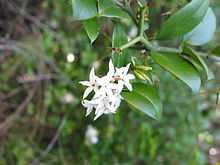Carissa
| Carissa | |
|---|---|
 | |
| Natal Plum (C. macrocarpa) | |
| Scientific classification | |
| Kingdom: | Plantae |
| (unranked): | Angiosperms |
| (unranked): | Eudicots |
| (unranked): | Asterids |
| Order: | Gentianales |
| Family: | Apocynaceae |
| Subfamily: | Rauvolfioideae |
| Tribe: | Carisseae |
| Genus: | Carissa L. |
| Synonyms[1] | |
| |


Carissa is a genus of shrubs or small trees native to tropical and subtropical regions of Africa, Australia and Asia. Until recently about 100 species were listed, but most of them have been relegated to the status of synonyms or assigned to other genera, such as Acokanthera.[2][3]
Description
Different species of Carissa grow as shrubs or trees, attaining respective heights of 2 to 10 m tall. They bear smooth, sharp thorns that often are formidable; they are true botanical thorns, being modified branches, morphologically speaking. The thorns may be simple, as in Carissa spinarum, dichotomously forked as in Carissa bispinosa, or dichotomously branched as in Carissa macrocarpa.
The leaves are a rich, glossy, waxy green, smooth, simple, entire and elliptic to ovate or nearly lanceolate. They are 2–8 cm long, partly depending on the species, and generally are thick and leathery. In suitable climates some species flower through most of the year. The flowers are nearly sessile, 1–5 cm diameter, with a five-lobed white or pink-tinged corolla. They may be solitary or borne in clusters in an umbel or corymb.[4] The flowers of some species some have a fragrance reminiscent of Gardenia, which adds to their popularity as garden plants. The fruit is a plum-like berry in the shape of a prolate spheroid, like that of a rugby ball. In colour they vary according to species. In some species they are red when ripe, whereas others turn a glossy purple-black. Typically they are 1.5–6 cm in length, and usually contain 1-4 flat brown seeds, but up to 16 in some species.
Fruit
The fruit of the carissa is an oblong berry which contains numerous small seeds.[5] The green fruit is poisonous, sometimes dangerously so. The ripe fruit are edible but may be fairly tart, and taste like a giant cranberry, though some species have fruity flavours with overtones of strawberry or apple. They are said to be rich in Vitamin C, calcium, magnesium and phosphorus. The fruit of C. macrocarpa are especially relished and eaten raw or used to make jelly. Various birds eat Carissa fruit and distribute the seed. If eaten before fully ripe, a bitter, poisonous latex is released from the skin. Other than the ripe fruit, the plant is poisonous, much like the related and dangerously poisonous genus Acokanthera.
Carissa carandas is grown in several Asiatic countries for its fruit, which is variously used in cooking and in folk medicine (see article).
Horticulture
Carissa species generally respond well to gardening and are valued in topiary and in forming strong, dense, decorative, thorny, flowering hedges. Some sprawling varieties are useful as ground covers.[6] Carissa species are grown from seed or cuttings and tolerate slight frost.
Species
The following species are recognised.[2]
- Carissa bispinosa (L.) Desf. ex Brenan - widespread in E + S Africa from Kenya to Cape Province
- Carissa boiviniana (Baill.) Leeuwenb. - Madagascar
- Carissa carandas L. - India, Bangladesh; naturalized in S China, Mauritius, Nepal, Pakistan, Indochina, Java, Philippines, West Indies
- Carissa haematocarpa (Eckl.) A.DC. - Namibia, Cape Province of South Africa
- Carissa macrocarpa (Eckl.) A.DC. - Kenya + Zaire south to Cape Province; naturalized in S China, Ascension Island, Hawaii, Florida, Texas, Mexico, Central America, West Indies
- Carissa pichoniana Leeuwenb. - Madagascar
- Carissa spinarum L. - Africa, Arabian Peninsula, Indian Subcontinent, Indochina, New Guinea, New Caledonia, Australia
- Carissa tetramera (Sacleux) Stapf - E + S Africa from Kenya to KwaZulu-Natal
- Formerly included
- Acokanthera oblongifolia (Hochst.) Codd (as C. oblongifolia Hochst.)
- Acokanthera schimperi (A.DC.) Benth. & Hook.f. ex Schweinf. (as C. schimperi A.DC.)
References
| Wikimedia Commons has media related to Carissa. |
| Wikispecies has information related to: Carissa |
- ↑ "World Checklist of Selected Plant Families". Retrieved May 21, 2014.
- ↑ 2.0 2.1 Kew World Checklist of Selected Plant Families
- ↑ "The Plant List: A Working List of All Plant Species, Version 1". 2010.
- ↑ Dyer, R. Allen, The Genera of Southern African Flowering Plants”. ISBN 0 621 02854 1, 1975
- ↑ Boning, Charles R. (2006). Florida’s Best Fruiting Plants: Native and Exotic Trees, Shrubs, and Vines. Sarasota, Florida: Pineapple Press, Inc. p. 61. ISBN 1561643726.
- ↑ Floridata page for Carissa macrocarpa